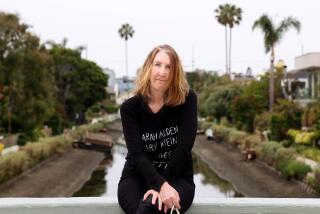City Putting Spark in Its Mass Transit
Burbank is going electric. This is not a Jay Leno tag line or a come-on for a new musical. For the first time in the San Fernando Valley, a city has invested in electric buses, replacing dirty, fossil-fuel-burning vehicles with the cleaner machines.
“We’re going to be so electrified I can’t stand it,” joked Robert Tague, Burbank community development director.
Four electric buses are scheduled to enter service in November. They will serve the city’s Metrolink station, providing free connections for commuters to three other high-density locations within the city.
Two additional electric buses, to be purchased with Metropolitan Transportation Authority grant money, are expected to be in service within a year on additional routes in the city. A fleet of 10 electric cars and pickup trucks is also planned for city workers’ use, though the purchase is still under discussion.
“This will be a first for us,” Tague said. “A first, as far as I know, for anyone in the Valley.”
Although Santa Monica currently uses electric vehicles for a limited shuttle service to beach areas, and other cities such as Glendale use electric vehicles for tests and limited public displays, Burbank will be the first to put such clean-fuel technology into widespread use, according to Mark Yamarone, Burbank’s principal transportation planner.
“Little by little, we’ll work the vehicles into our transportation system,” he said.
Some vehicles in the county, including some buses in Glendale, already use compressed natural gas, which burns more cleanly than diesel or other fossil fuels. But only Burbank has plans for fleets of electric vehicles, which are virtually nonpolluting.
“Burbank is not the absolute leader, but they’re on the cutting edge,” said Bill Van Amburg, spokesman for CalStart, a consortium of advanced transportation technology companies based in the San Fernando Valley. “Most cities that even have electric cars only have one or two. To have 10, that’s a significant commitment.”
“It’s impressive,” he added.
The purchase of four electric buses, Van Amburg said, represents a serious commitment to electric-powered vehicles.
“Nationally, there’s about 100 electric buses in operation,” he noted, adding that Santa Barbara and Chattanooga, Tenn., are among the leaders. Chattanooga, he said, operates 15 of the buses.
APS Systems in Oxnard, the manufacturer of Burbank’s buses, has produced 21 for users worldwide, said Ed Attelian, president of APS. Most are in use in Santa Barbara and Santa Monica.
Burbank’s four new buses--out of a fleet of 23--cost a total of $960,000, roughly twice the cost of conventional vehicles. The city paid for roughly half the cost while the Burbank Redevelopment Agency covered the rest, Yamarone said. The regional South Coast Air Quality Management District is helping pay for implementation and equipment costs, he said.
While electric vehicles are far less “dirty” in terms of air pollution, according to transportation officials, they are not perfectly “clean” either.
Regularly fueled buses, which are typically powered by diesel fuel, emit more than 7,000 pounds of pollutants into the air annually, according to a Burbank analysis. Electric buses, by contrast, emit roughly 44 pounds of toxins into the air each year, mostly through the generator stations used to recharge the vehicles.
Santa Barbara has operated electric buses since 1991, making the city one of the nation’s pioneers in electrically-powered vehicles. The city’s 18 electric buses make it the nation’s largest municipal operator of electric vehicles.
Much of the pollution associated with internal-combustion engines is believed to add to ground-level ozone problems and, possibly, contributes to the greenhouse effect--the heating of the earth’s atmosphere. Electric-powered vehicles, by comparison, release minute amounts of the same pollutants: carbon dioxide, carbon monoxide, nitrogen oxides and other chemical compounds associated with air pollution.
“We’re hoping to be clean, without sacrificing service,” Tague said, noting that Burbank’s plans for electric vehicles are not unique in Southern California. “But we’re not inventing the wheel here. Santa Barbara has already developed this technology. They’re leading the way for us.”
Burbank Mayor Bob Kramer said that the city needs to build four additional charging stations for the new vehicles. The city already has one station, which was built when Assemblyman Scott Wildman (D-Los Angeles) purchased an electric car for his Burbank district office earlier this year. Wildman helped Burbank secure state funds for the 10 electric vehicles, which will cost $250,000, for city workers.
The state money does not cover all the costs of additional charging equipment however.
While Burbank has yet to conduct a survey of the costs and benefits of going electric, officials here agreed that reducing pollution is worth the cost.
“We haven’t done any studies on how cost-effective it will be, but we think it will be,” Tague said. “After all, we are the power provider here now.”
Electricity for the generators that will keep the city’s electric vehicle fleet charged will be supplied by the Burbank Public Service Department, the city-owned water and power utility.
More to Read
Sign up for Essential California
The most important California stories and recommendations in your inbox every morning.
You may occasionally receive promotional content from the Los Angeles Times.










